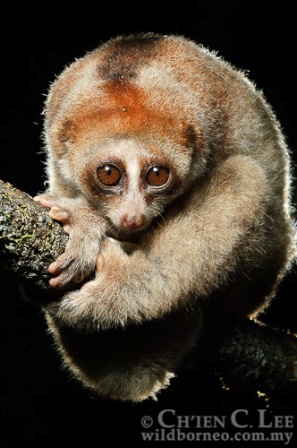
Venom
Nycticebus coucang is one of the two venomous mammals that exist, with the other being the platypus; however, the slow loris is the only venomous primate.
A venomous animal, like the
sea snake, typically has direct access to its venom, but
it is controversial whether or not the slow loris be called
venomous because the venom is only acquired
through grooming. The venom from Nycticebus coucang comes from the
brachial glands on its arms. This gland produces an oily
secretion and can be found in adolescents as young as 6 weeks
old.
As a slow loris is grooming itself, the venom from this gland gets into a unique structure in their mouths called a tooth comb. The tooth comb is used for grooming and can transfer venom to baby slow lorises and to itself (see Reproduction). The dental comb is formed on the lower jaw in a slow lorises' incisors.

The venom has no need to be used on prey so it is solely a
defense mechanism. These animals are typically non-aggressive
and only bite when they feel very threatened. It is unclear whether or not the slow loris
bites with its toxin to scare a predator or attacker off or if it is
to incapacitate the attacker so it can get away. The venom contains
about 200 volatile components to it and the structure of the venom
is not yet known. The venom emits disgusting and
nauseating smells from both the toothcomb in the mouth and directly
from the brachial glands. The strong smelling substance is usually released in times of stress. When this secretion gets
into the mouth and is mixed with saliva, the oily substance becomes
toxic.
Nycticebus pygmaeous species can secrete the same venom
as Nycticebus coucang species so some consider these
animals to be the same species (see
Classification). Most types of slow loris can secrete venom, but
the venom is not toxic in all species.

There have been reports of people getting bit, but they are
typically safe as pets. Bites from a slow loris can be extremely painful and have been
known to cause illness and even death in humans in some
circumstances. Those who have severe allergies can go into
anaphylactic shock
minutes after a bite has happened. Some symptoms of the venom
include itchy red skin, a decrease in blood pressure, shock, painful
muscle convulsions, respiratory, and heart problems.
When a slow loris is avoiding attack, it will wrap its limbs around itself which can spread the venom onto its fur protecting itself from being bitten a second time if an animal decides to attack. (See Interactions)
Want to know where I found the information? See References!
To see the creator of this page, see Contact Me!
To see other cool organisms, visit MulitpleOrganisms.net!
Back to Homepage